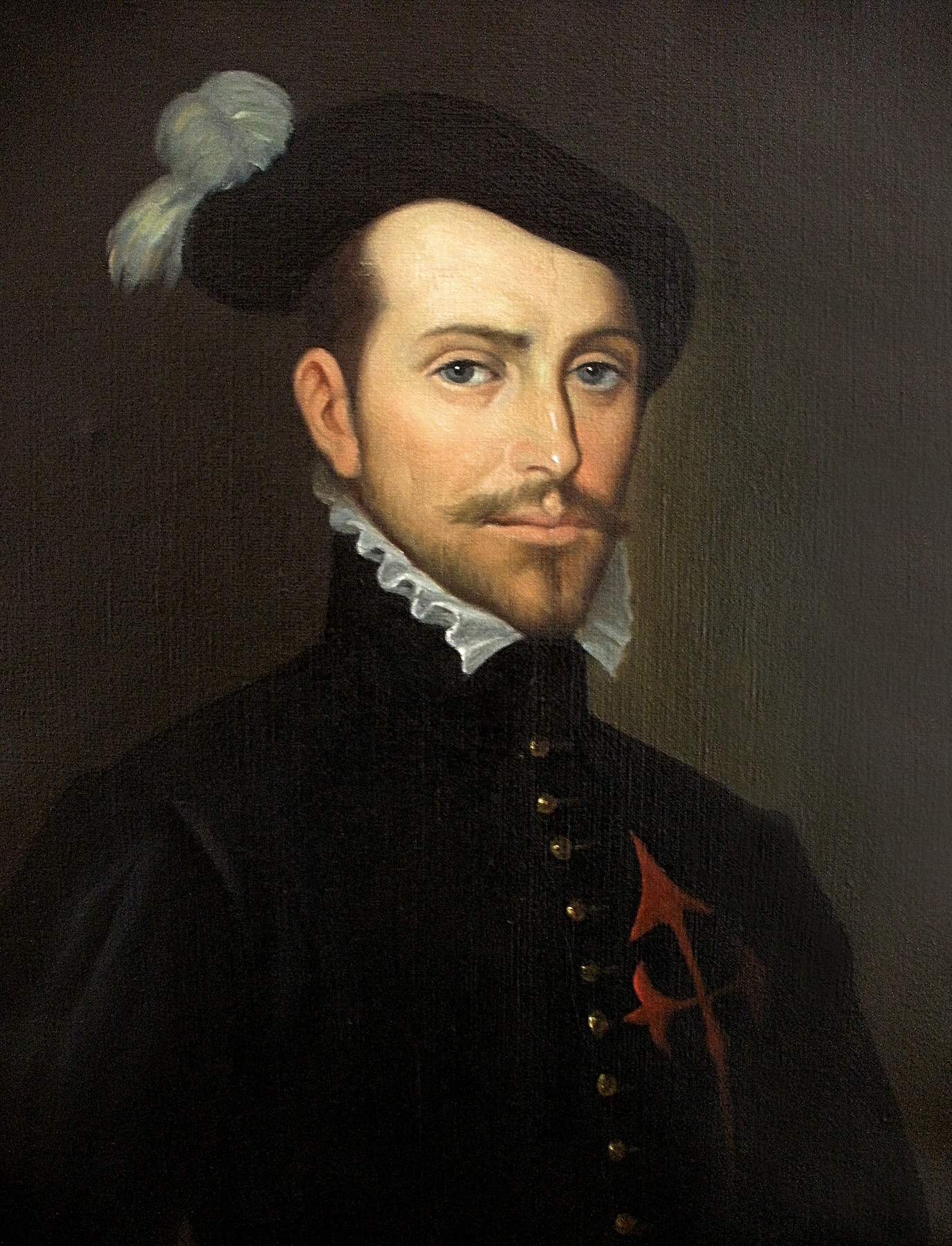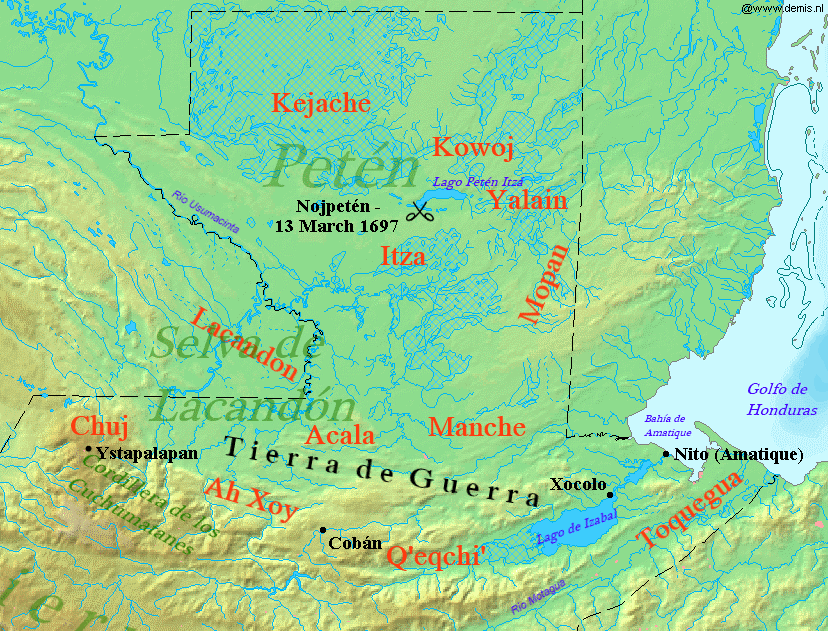|
Spanish Conquest Of Guatemala
In a protracted conflict during the Spanish colonization of the Americas, Spanish colonisers gradually incorporated the territory that became the modern country of Guatemala into the colonial Viceroyalty of New Spain. Before the conquest, this territory contained a number of competing Mesoamerican kingdoms, the majority of which were Maya. Many conquistadors viewed the Maya as "infidels" who needed to be forcefully converted and pacified, disregarding the achievements of their civilization.Jones 2000, p. 356. The first contact between the Maya and European explorers came in the early 16th century when a Spanish ship sailing from Panama to Santo Domingo was wrecked on the east coast of the Yucatán Peninsula in 1511. Several Spanish expeditions followed in 1517 and 1519, making landfall on various parts of the Yucatán coast. The Spanish conquest of the Maya was a prolonged affair; the Maya kingdoms resisted integration into the Spanish Empire with such tenacity that their defeat t ... [...More Info...] [...Related Items...] OR: [Wikipedia] [Google] [Baidu] |
Pedro De Alvarado
Pedro de Alvarado (; c. 1485 – 4 July 1541) was a Spanish conquistador and governor of Guatemala.Lovell, Lutz and Swezey 1984, p. 461. He participated in the conquest of Cuba, in Juan de Grijalva's exploration of the coasts of the Yucatán Peninsula and the Gulf of Mexico, and in the conquest of the Aztec Empire led by Hernán Cortés. He is considered the conquistador of much of Central America, including Guatemala, Honduras and El Salvador. Character and appearance Pedro de Alvarado was flamboyant and charismatic, and was both a brilliant military commander and a cruel, hardened man. His hair and beard were red, which reminded the Aztecs of their sun-god (often painted red) Tōnatiuh. He was handsome, and presented an affable appearance, but was volatile and quick to anger.Burland 1973, p. 216. He was ruthless in his dealings with the indigenous peoples he set out to conquer. Historians judge that his greed drove him to excessive cruelty,Recinos 1986, p. 205. and his ... [...More Info...] [...Related Items...] OR: [Wikipedia] [Google] [Baidu] |
Poqomam People
The Poqomam are a Maya people in Guatemala and El Salvador. Their indigenous language is also called Poqomam and is closely related to Poqomchi'. Notable Poqomam settlements are located in Chinautla (Guatemala (department)), Palín (Escuintla), and in San Luis Jilotepeque (Jalapa). Before the Spanish Conquest, the Poqomam had their capital at Chinautla Viejo.Hill 1996, p.82. Carmack 2001, p.158. The Poqomam that advanced further east, to the territories of present-day El Salvador, were largely displaced by the migration of the Pipil people in the 11th century. The few Poqomam that remained in El Salvador live near the Guatemala border, in the departments of Santa Ana and Ahuachapan. See also * Mixco Viejo Mixco Viejo () ("Old Mixco"), occasionally spelt Mixcu Viejo, is an archaeological site in the north east of the Chimaltenango department of Guatemala, some to the north of Guatemala City and from the junction of the rivers Pixcaya and Mo ... Notes References * ... [...More Info...] [...Related Items...] OR: [Wikipedia] [Google] [Baidu] |
Kaybʼil Bʼalam
Kaybʼil Bʼalam (alternatively written Kaibil Balam) was a 16th-century leader of the Mam people in the Maya kingdom in the western highlands of Guatemala. During the time of the Spanish invasion, the Mam population was mainly situated in Xinabahul (now modern-day Huehuetenango). However, due to the Spanish conquest, the people returned to the stone fortifications of Zaculeu for protection. The city was attacked in 1525 by '' conquistador'' Gonzalo de Alvarado y Contreras, brother of Pedro de Alvarado. Kaybʼil Bʼalam and his warriors successfully repelled the attempted siege by the Spanish forces for several months until being forced to surrender after being reduced to the verge of starvation.Recinos 1986, p.110. In 1975, the Guatemalan Army created a special operations force, the Kaibiles, named after Kaybʼil Bʼalam. The group is centered out of Huehuetenango Huehuetenango () is a city and municipality in the highlands of western Guatemala. It is also the capital of the ... [...More Info...] [...Related Items...] OR: [Wikipedia] [Google] [Baidu] |
Kan Ekʼ
Kan Ekʼ (sometimes spelt Canek) was the name or title used by the Itza Maya kings at their island capital Nojpetén upon Lake Petén Itzá in the Petén Department of Guatemala. The full title was Aj Kan Ekʼ or Ajaw Kan Ekʼ , and in some studies Kan Ekʼ is used as the name of the Late Postclassic (c. 1200 to 1697) Petén Itza polity. The earliest known use of the title comes from a Maya stela at the archaeological site of Yaxchilan and dates to the mid 8th century AD. The name is recorded in inscriptions at widely spaced Maya cities including Seibal, Motul de San José and Chichen Itza. When Spanish conquistador Hernán Cortés crossed Petén in the early 16th century, he met with an Itza king identified by the name Kan Ekʼ. The Itza were not contacted again until the early 17th century when Franciscan friars were initially welcomed by the current Aj Kan Ekʼ before being expelled. This was followed by several incidents in which attempts to interact with the Itza res ... [...More Info...] [...Related Items...] OR: [Wikipedia] [Google] [Baidu] |
Martín De Ursúa
Martín de Ursúa (or Urzúa) y Arizmendi (; February 22, 1653 – February 4, 1715), Count of Lizárraga and of Castillo, was a Spanish Basque conquistador in Central America during the late colonial period of New Spain. Born in Olóriz, Navarre,Jones 1998, p. 113. he is noted for leading the 1696–97 expeditionary force which resulted in the fall of the last significant independent Maya stronghold, Nojpetén, located on an island in Lake Petén Itzá in the northern Petén Basin region of present-day Guatemala. He served as governor of the Yucatán until 1708, when he was named Governor-General of the Philippines. Around the time that he was named to that post, he was made a knight of the Order of Santiago. He died in Manila in 1715.Jones 1998, p. 114. Ursúa arrived to Mexico around 1680 and initially served as a lawyer in Mexico City until 1692. He used this period to cement relationships with colonial officials in Yucatán.Jones 1998, p. 118. In 1692 he was appoin ... [...More Info...] [...Related Items...] OR: [Wikipedia] [Google] [Baidu] |
Hernán Cortés
Hernán Cortés de Monroy y Pizarro Altamirano, 1st Marquess of the Valley of Oaxaca (; ; 1485 – December 2, 1547) was a Spanish ''conquistador'' who led an expedition that caused the fall of the Aztec Empire and brought large portions of what is now mainland Mexico under the rule of the King of Castile in the early 16th century. Cortés was part of the generation of Spanish explorers and conquistadors who began the first phase of the Spanish colonization of the Americas. Born in Medellín, Spain, to a family of lesser nobility, Cortés chose to pursue adventure and riches in the New World. He went to Hispaniola and later to Cuba, where he received an '' encomienda'' (the right to the labor of certain subjects). For a short time, he served as '' alcalde'' (magistrate) of the second Spanish town founded on the island. In 1519, he was elected captain of the third expedition to the mainland, which he partly funded. His enmity with the Governor of Cuba, Diego Velázquez de Cu ... [...More Info...] [...Related Items...] OR: [Wikipedia] [Google] [Baidu] |
Gonzalo De Alvarado
Gonzalo de Alvarado y Contreras was a Spanish conquistador and brother of Pedro de Alvarado who participated in campaigns in Mexico, Guatemala, and El Salvador (co-founding its present capital, San Salvador). Gonzalo de Alvarado was a native of Badajoz and son of Diego Gómez de Alvarado y Mexía de Sandoval, born in Badajoz in 1460 and ''vecino'' of Badajoz, Extremadura, Commander of Lobón,"Conquered Conquistadors" ''Florine G.L. Asselbergs'', First Edition, published 2004 Puebla, Montijo and Cubillana, ''Alcalde'' of Montánchez, ''Trece'' of the Order of Santiago, Lord of Castellanos, '' Maestresala'' of Henry IV of Castile and General of the Frontier of Portugal, widow of Teresa Suárez de Moscoso y Figueroa, and second wife Leonor de Contreras y Gutiérrez de Trejo. Alvarado y Contreras went to Hispaniola in 1510 with all his older brother Pedro and younger brothers Jorge, Gómez, Hernando and Juan and their uncle Diego de Alvarado y Mexía de Sandoval. When Pedro de Al ... [...More Info...] [...Related Items...] OR: [Wikipedia] [Google] [Baidu] |
Yalain
The Yalain have been proposed as a Maya polity that existed during the Postclassic period (c. AD 1000–1697) in the Petén Basin of northern Guatemala, based in the central Petén lakes region.Rice and Rice 2009, p. 11. A small town called Yalain was described in 1696 by the Franciscan friar Andrés de Avendaño y Loyola. It was said to consist of a relatively small number of residences clustered within rich agricultural land. The town was located to the east of Lake Petén Itzá and was said to have been farmed by the inhabitants of Nojpetén, the capital city of the Itza kingdom. The political extent and archaeology of the Yalain is poorly understood. Proposed territory The existence of the Yalain was first proposed by Grant D. Jones. Jones suggested that their territory was based around the town of the same name on the shores of Lake Macanché and extended eastwards into the drainage of the Yaxhá and Sacnab lakes. This area was formerly Kowoj territory and was aggressively ... [...More Info...] [...Related Items...] OR: [Wikipedia] [Google] [Baidu] |
Xinca People
The Xinka, or Xinca, are a non-Mayan indigenous people of Mesoamerica, with communities in the southern portion of Guatemala, near its border with El Salvador, and in the mountainous region to the north. Their languages (the Xincan languages) are not known to be related to any other language family,Coe 1999, p.38. although they have many loan words from Mayan languages. The Xinka may have been among the earliest inhabitants of southeastern Guatemala, predating the arrival of the Maya and the Pipil. Population In the 2018 National Census, a total of 264,167 individuals identified themselves as Xinka, representing 1.8% of the national population.https://www.censopoblacion.gt/dondeestamos After a revivalist movement led by the two main Xinka political organizations in Guatemala, self identified Xincas increased from 16,214 individuals in 2002 to 264,167 in 2018. History Before the arrival of the Spanish in the early 16th century, the eastern portion of the Guatemalan Pacific plain ... [...More Info...] [...Related Items...] OR: [Wikipedia] [Google] [Baidu] |



